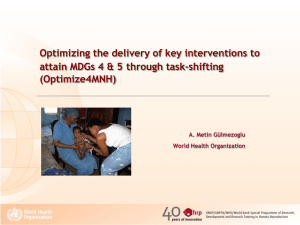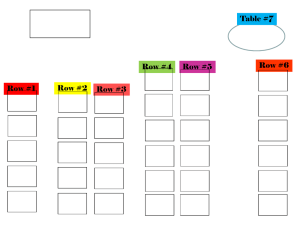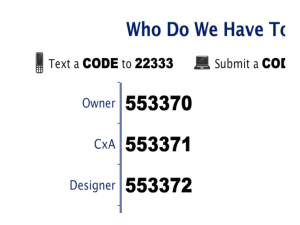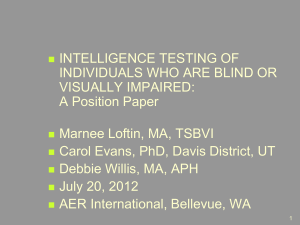SQA_G_003_8D_Guideline_EN
advertisement
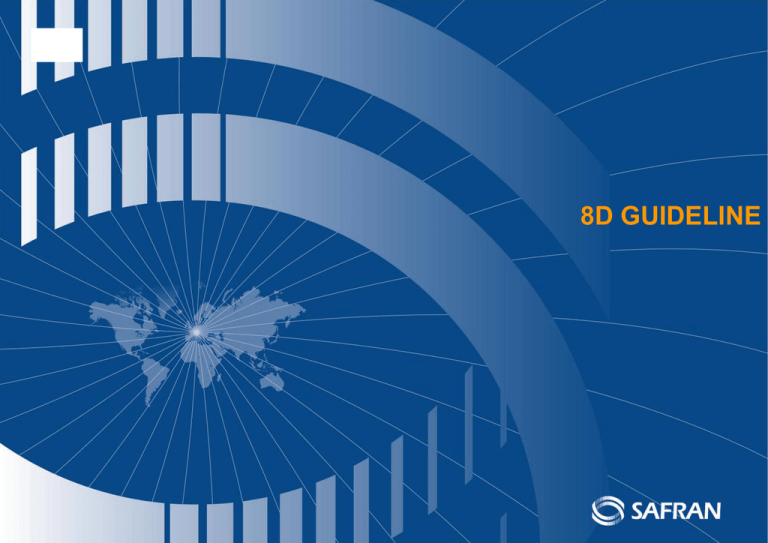
8D GUIDELINE « Ce document et les informations qu’il contient sont la propriété de Aircelle. Ils ne doivent pas être copiés ni communiqués à un tiers sans l’autorisation préalable et écrite de Aircelle. ». Guideline 8D Guideline 8D AQF 8D / Objectives Eradicate issues by catching the root cause. Permanently use a structured methodology for issue resolution in order to: - Immediately contain and limit the issue - Implement adequate preventive and corrective actions Promote multi skilled team work Share and progress continuously 8D Guideline Page 1 8D / Synopsis 1 2 3 4 5 Contain Define Team Describe the issue 6 8 Eradicate Secure customer WWWWHW Root cause analysis Brainstorming Action plan set up Efficiency measure Prevent, capitalize Communicate, congratulate ISHIKAWA / 5Why? Eradicate = 3 months max* Contain = 48 hours * Eradication lead-time is function of the complexity of the implemented solutions 8D Guideline 7 Page 2 Enlarge / Capitalize 8D / THE FORM AT A GLANCE 8D Guideline Page 3 8D / « Administrative » references Part-Number / both references (company & Supplier) if need be Your company Chrono reference 8D Reference SQA8D_0912 8D opening date 05/02/09 Product or process reference Update: 12 h Beam … 11/02/09 TRIGGER ELEMENT Origin Supplier Internal Customer Type & reference of the notification: Mail Quality reclamation Concession Other Ref: Ref: Ref: Ref: Safran CAR 200_-503 Identification of the trigger (internal or external) and associated reference Leader (at the supplier) 8D Leader 8D closure date Goal dates lead-time Goal leadtime: Acknowledgement feedback (in case of customer claim) Containment / Customer Corrective actions implementation 8D Guideline Page 4 8D / First meeting Team constitution and issue description are key elements for an efficient containment action. At this extent, during 1st meeting: • • • 8D Guideline Remind the objectives Make sure the issue is clearly understood Determine extensively how to best secure the customer Page 5 8D / DETAILED VIEW – STEP 1 D1 - TEAM MEMBERS NAMES 8D Guideline FUNCTIONS Page 6 8D / Step 1 : Team constitution D1 - TEAM MEMBERS NAMES John Mark Theresa Clair FUNCTIONS Manufacturing Enginner Operator / Lay-up Production Quality Leader / 8D leader Inspector The team has to be relevant in terms of skills, background and size • • • Composition : it must be pertinent regarding the issue, calls out the right departments and the experts. Attention : do not forget key actors, such as people from an other production site, or a supplier, a customer… Leader : he must be designated and is responsible of the correct coordination of the 8D, up to the end (8 steps). Intercessions are really important to follow-up. Presenter : he knows the methodology and has got animation competencies, in order to make the meeting alive and to drive people to the issue resolution . It is neither necessarily the leader, nor someone from quality department. 8D Guideline Page 7 8D / DETAILED VIEW – STEP 2 D2 - CARACTERISATION AND QUANTIFICATION OF THE PROBLEM Problem clear description (precise references if adequate): Tracability (Despatch note, Batch / Serial Numbers…) and affected quantities Can this issue affect similar parts ? similar process ? parts already shipped to the customer ? 8D Guideline NO YES Is this issue recurrent ? Which ones ? YES NO YES NO YES NO Page 8 TOOL = WWWWHW 8D / Step 2 : Describe the issue Use WWWWHW tab when the subject is not deeply enough known / detailed / documented The subject must be described in a very factual manner (how?), so as not be discussed further on. Characterization of the issue Describe a “Should” compared to a “Should be” Attach sketch, picture, draw whenever necessary Traceability : mention Date / affected quantity Delivery note / manufacturing number Reference Serial or batch N° 8D Guideline Page 9 TOOL = WWWWHW 8D / Step 2 : Describe the issue 8D Guideline Page 10 8D / DETAILED VIEW – STEP 3 D3 - CONTAINMENT (IMMEDIATE ACTIONS) What are the performed actions to prevent the delivery of NC products or processes ? Area Action Manufacturing WIP (incl. At dispatch) Stores (incl. Support) Stores (assy lines) Supplier returns Supplier WIP Supplier stores Customer WIP Other How are conforming products identified ? Tracability for next conforming products (Despatch Note, CoC, Introduction batch…) 8D Guideline Page 11 Responsible 8D / Step 3 : Contain (immediate actions) List ALL parts (batches, S/N) that could be affected by the issue so as to inspect them and to make a clear statement about their conformity. IDENTIFY the parts in a visible and unquestionable way (GREEN/RED labels for example) and TRACE this inventory. Do not forget parts that could be in the transport, in the manufacturing process, at the customer, at the suppliers. Wonder about WHEN the non-conformance should have been detected to guide your mind. Containment can also be: stop the process, quarantine parts, return parts to the supplier or make necessary actions to make sure parts do conform to the design. D3 - CONTAINMENT (IMMEDIATE ACTIONS) What are the performed actions to prevent the delivery of NC products or processes ? Area Action Manufacturing WIP (incl. At dispatch) Stores (incl. Support) Stores (assy lines) Supplier returns Supplier WIP Supplier stores Inspection according to routine ACD, see inventory screening attached N/A = no parts Inspection according to routine ACD, see inventory screening attached N/A = no parts N/A = no parts N/A = no parts Inspection according to routine ACD, see Customer WIP inventory screening attached Other How are conforming products identified ? GREEN LABEL ON THE PACKAGING Tracability for next conforming products (Despatch Note, CoC, Introduction batch…) S/N130 Responsible Mr A Mr A Mr B CONTAIN IS PROTECTING ITS CUSTOMER TO RECEIVE NON-CONFORMING PARTS 8D Guideline Page 12 8D / DETAILED VIEW – STEP 4 D4 - CAUSES SEARCH (cf. Ishikawa or 5W if need be) Ref Potential Cause Priority Verification The issue should have been detected: At the supplier At Goods Inwards During manufacture During in-step inspections During final inspection Before dispatch Other: Reason(s) for non detection: 8D Guideline Page 13 Responsible & date TOOLS = Brainstorming ISHIKAWA 5 Why’s ? 8D / Step 4 : Root cause analysis_1 Root cause analysis can be driven in different ways: Ishikawa, 5 why’s … Case of an Ishikawa: At the right of the main arrow, indicate the issue, At the end of each single arrow, indicate the 5M : Machinery, Manpower, Material, environMent, Method, Note: in certain cases, instead o the 5M, it is possible to indicate the process steps For each “M”, list all the linked potential causes. Potential causes issue 5M 8D Guideline Page 14 8D / Step 4 : Root cause analysis_2 Case of a 5 why’s The 1st why is why did the issue occur ? And to each answer, an other why is asked, up to the root cause. The implementation of such a method can be called causes tree. 8D Guideline Page 15 TOOLS = Brainstorming ISHIKAWA 5 Why’s ? 8D / Step 4 : Root cause analysis_3 TOOLS = Brainstorming ISHIKAWA 5 Why’s ? For a beginning team in root cause analysis process, prefer a post it’ version. The presenter role is to drive the analyze without influencing and to prioritize. Do not reject any idea, do not deny any idea to start with. Precise on the Ishikawa the influent parameters, and not a potential defect. E.g.: « Lay-up personnel training » and not « personnel training not performed » Once potential causes identified, they will be either cleared or confirmed as real causes. Note: they can be immediately cleared (by logic, history, data, etc.) or deeper analyze can be necessary to clear or confirm (lab test, process analyze, documentary check, etc. ). The color tag will enable to visualize the cause status: cleared Green tag WIP TBD primary Red tag secondary Orange tag 8D Guideline Page 16 8D / Step 4 : Root cause analysis_4 TOOLS = ISHIKAWA 5 Why’s ? Brainstorming Example : Potential causes already cleared = These are not causes Causes not cleared yet Confirmed cause 8D Guideline Page 17 8D / Step 4 : Root cause analysis_5 TOOLS = ISHIKAWA 5 Why’s ? Brainstorming Identify which actions will enable to clear the potential causes, also identify responsibles of the actions and the leadtime. Identify the priority of the clearance actions (estimation based on the fact that if the cause is confirmed, then the cause will be either primary or secondary). Once checks performed, indicate what the results are in the verification cell, and do not forget to update the color of the tag in the Ishikawa diagram, up to full update (no more TBD). References are identical to the Ishikawa ones. Potential causes to be checked as a priority (red square) Checked cause (this is why te priority square has been removed) 8D Guideline Page 18 8D / DETAILED VIEW – STEP 5 D5 - DEFINE & PLAN PERMANENT CORRECTIVE ACTIONS Ref 8D Guideline Action Responsible Page 19 Leadtime Completed 8D / Step 5 : Action plan set up Once the root causes are identified, the permanent correctives actions that will enable to eradicate the issue can be defined. Each action has got a responsible and a lead-time. Obviously, the 8D leader will check that actions are implemented within due date. References are identical to the Ishikawa ones. D5 - DEFINE & PLAN PERMANENT CORRECTIVE ACTIONS Ref C2 Action Tooling Repair Responsible C2 Cutter restriction in Aircelle clean room Leadtime Completed Mr JK 27/02/09 26/02/09 Ms UM 13/02/09 10/02/09 Remark : each responsible is liable for his single action. The 8D leader is liable for the overall action plan. 8D Guideline Page 20 8D / DETAILED VIEW – STEP 6 D6 - IMPLEMENT ACTIONS PLAN & EFFICIENCY EVIDENCE Record evidence of actions implementation Are completed actions confirmed as being efficient ? YES NO Record evidence of actions efficiency (eg: non recurrence of this issues on X manufactures/deliveries, etc.) 8D Guideline Page 21 8D / Step 6 : Implementation and efficiency evidence It is important to collect all evidences of the implementation of the actions, and to gather them in the “Additional elements” tab Demonstrate in a non-arguable way the efficiency, by recording evidence elements: E.g.: 10 successive conform serials (S/N 151 to 160) 8D Guideline D6 - IMPLEMENT ACTIONS PLAN & EFFICIENCY EVIDENCE Record evidence of actions implementation See attached file: maintenance plan.doc, instruction AFJ.pdf, routine version B.pdf Are completed actions confirmed as being efficient ? YES NO Record evidence of actions efficiency (eg: non recurrence of this issues on X manufactures/deliveries, etc.) S/N151 to 160 are conforming. Refer to inspection data in "Additional elements" tab. Page 22 8D / DETAILED VIEW – STEP 7 D7-CAPITALIZE, IMPLEMENT PREVENTIVE ACTIONS After actions implementation, do following elements need update ? Reference Responsible Leadtime Responsible Leadtime Instruction sheets Instructions/ control means Production flow FMEA (product and process) Drawings Maintenance plan Other products or similar process Sub-tiers follow-up Documents of the quality system Customer elements Other Other preventive actions to be implemented: Ref 8D Guideline Action Page 23 Completed 8D / Step 7 : Capitalize, Implement preventive actions Put the fix at the highest possible level, in order to manage this type of issue the soonest. E.g.: modification of the specification « customer requirements acknowledgement », implementation of lessons learnt data base, accessible from all, global maintenance plan implementation, etc. Capitalize on other process / product type E.g.: preventive modification of the instructions of similar products Get a « supply chain » reflex in order to make sure prevention is applied all along the process All these actions must also have responsible and lead-time THIS IS THE MOST DIFFICULT STEP BUT ALSO ONE OF THE MAJOR STEPS TO BENEFIT FROM CONTINUOUS IMPROVEMENT LOOP (PDCA) 8D Guideline Page 24 8D / DETAILED VIEW – STEP 8 D8 - COMMUNICATE & PROMOTE EXPERIENCE (To the customer, to other departments….) 8D Guideline Page 25 8D / Step 8 : Communicate, Congratulate Gather and congratulate members (participants…) of the team Communicate the definitive closure information to all areas / people that need the information (internal, customers, suppliers) File the 8D and perform its lessons learnt if need be in order to standardize practices. 8D Guideline Page 26


